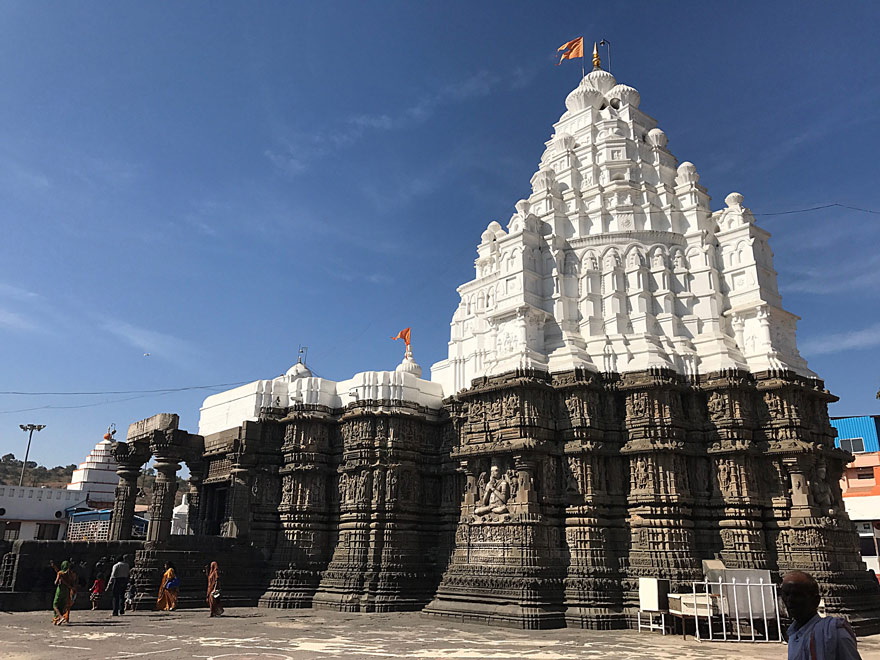
As the day broke, the jasmine flowers falling with the dawn and the droplets of dew on the grass, hued with grey and blue, seemed to offer themselves while welcoming the slowly incarnating chariot ridden Sun, opening the gates of the eastern horizon.
In Aurangabad, the adventing lord Sun seemed captivating while taking a stroll in the garden of hotel Rama International, affiliated to the Welcome Group. However, it was time to resume our journey towards the celebrated Jyotirlinga of Lord Shiva, the eighth in our journey of the 12 divine jyotirlingas. We started sharp at 7 in the morning, to visit the pious jyotirlinga of Shri Nageshwar. The initial part of the 200km drive is somewhat comfortable with the four lane, but the single lane in the last lapse makes the drive a bit uncomfortable.
It takes around 3 and a half hours to complete the journey to the Aundha Village of Hingoli district via Nagpur-Mumbai National Highway and the state highway of Jalna-Jintur.
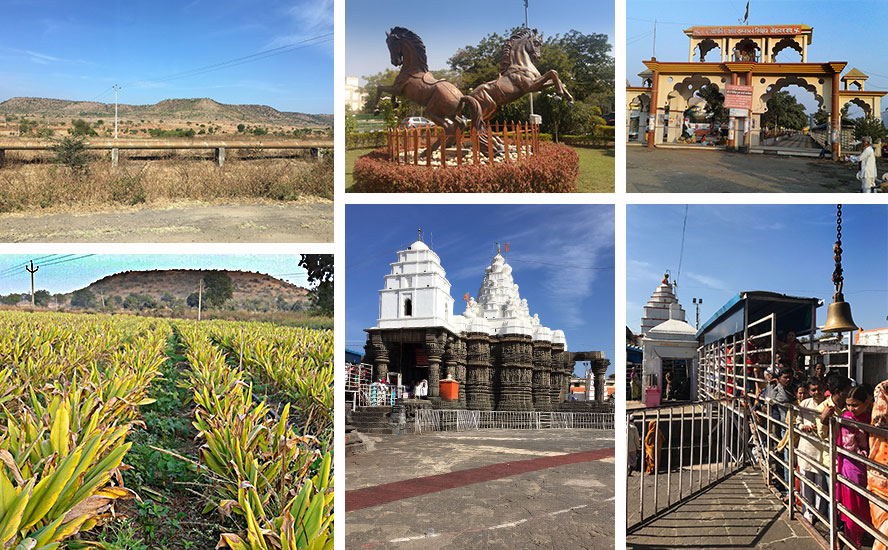
Glimpses of the Journey
The lush green turmeric, soybean and gram fields snooping from the bushes and the huts on the flat lands, keep the mind engaged on our way. The mountain peaks beaming with sunlight don’t let us blink an eye. Following us one after the other, the long mountain range captivated our soul. To quench our curiosity and to gather information on these mountains, we contacted Nashik’s senior Geography scholar, Professor Dr.Pramod kumar Shivajirao Hire. He described it as the Harishchandra Range of Balaghat chain, which originate from the western ghats and go up to the border of Karnataka.
Now, the question popped in our minds that could these be in anyway related to the tale of Raja Harishchandra? A senior researcher of Sri Triyambak area, Sri Rajesh Dikshit shared the information of Raja Harsihchandra’s austerities in this region. After getting acquitted from the curse of Vishvamitra, the suryavanshi king embraced Vanprastha Ashram and roamed in this valley and forest.
Driving through the interrupting visuals of the old Banyan trees canopying the road, our eyes ceased at an interesting site. Far in the village, we saw Vasudevs draped in a white loincloth(dhoti) and a vest (Angarakha) wearing a peackock feathered cap, playing Manjiras and chanting bhajans.
In Maharashtra, the villagers use to give benefactions to these people, as they sang the aubade of Vasudev Ala Re Aala…Daan pavla Daan Pavla, at the time of “Sada-Sammarjan” (making rangoli after cleaning and sprinkling water on the floor) in the morning. However, today they earn livelihood by devotional singing.
Gazing the Khillari Bulls, the one with a hanging dewlap, deoni and lal khandari cows, known for yielding more milk, we reached to Aundha. Incidentally, Aundha is also easily accesible by the rail route from Nanded, Parbhani or by public transport buses from Akola to Hingoli.
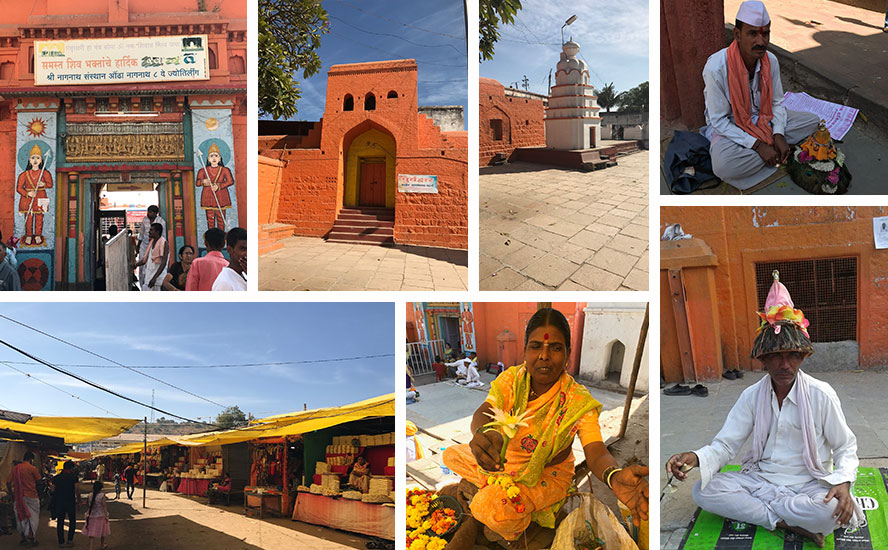
The divine abode of the benevolent Shiva, is right infront of the bus stand. Here one notices several shops selling Poojan saamagri and peackock feathered caps adorning Vasudevs, blessing the devotees. Entering the pious Shivalaya, enclosed around a forest reserve full of Sal, Sagaoun & Tendu leaves and a countryside untouched by the glamor and fancy of the cities, we felt that the one who is prevalent in the futile and formless, is enriched here. Truly, our heavenly pilgrims are enriched with the elements of supreme consciousness. These substances,the offerings are all real godly treasures and all this is the self-frolic of the inconceivable.
By now, we had entered a huge campus. After paying Rs.100 for the Special Darshan at the Nageshwar Sansthan Office, we were gazing at the astonishing sculpture of the Shivalaya. The campus of this Shiva Shrine, set in a sprawling 60000 sq ft., is secured with a wall of 6 meter height. It has 4 entrance gates.
The Shivalaya placed on 75 ft.wide, 150 ft. long and 8 ft. high, black flagstones spread in 7200 sq.ft. area in the centre of the grand premises, has a Kalash atop at a height of 60 ft.
Made up of with limestones, the white tinted peak has a height of 31 ft. This restoration work is an offering of the highly regarded Queen Devi Ahilyabai Holkar. The excellent sculpture of this Shivalaya sans a foundation stone, makes us feel that the sculptors have infused the industriousness of their whole life in these idols.
The 60 panels above the surface of the ground are an innovative display, in the panels above(known as Thar in Archaeological science) the episodes of Elephant Corps, Horse Platoon, Military Power and Battle are uniquely visualised.
Vishnu sits on the North faced complex of the Shivalaya, whereas Bramha is in the East and Ganga parvati are seated along with Rudra on the south.
The Tandav dance of the snake adorned Shiva Idol, the Dashanana seated in the Ravana Garvharana Idol, the sweetness of the grand Shiva and the originator of the three worlds Parvati in the moments of pleasure, the stunning execution of these terracotta idols of Shiva family, establishes high parameters of brilliance of the sculptors.
Gazing and appreciating the sculptures showcasing archeological excellence, depicting the world above and the underworld, flawlessly sculpted references of Ramayan and Mahabharat, the beauty, the rings, the vajratika, the bangles, the pearl necklace, the beautiful curves and postures of the hermit, the demigods and the goddess we completed the circumambulate of the temple.
Here we met the Upadhyey of Sri Nageshwar Jyotirlinga, Pandit Darshan Nagnathrao Pathak. Citing the Kaveri khand of the Padmapuraana, he tells that Lord Vishwakarma himself created this holy abode of the Nageshwar jyotirlinga. The black stone used in the creation of the shivalaya was sourced from a distance of 16 Kos (miles) from the place. While 89000 gold coins were spent on Black oil, used to keep the vehicles bringing these stones well lubricated during the task. Sri Pathak further tells that from the advent of the first century to the 14th century, financial assistance to maintain and manage the place was continuously rendered by Saatvaahan, Uttar Chalukya, Poorva Chalukya, Rashtrakoot Kadamb, Vaakatak Silahaar, and Yadava Dynasties. A flagstone has also been found citing a donation amount by the Vakatak Kings of Vashi, for the lamp and wick of the temple.
A copperplate excavated from Kaundilyapur validates that the King Govind the third, also visited Nageshwara weheras it also tells about a Goddess Kankeshwari temple in the south. There are also evidences of the Saatvahan Kings, who ruled for 460 years, visiting the revered Nageshwar Jyotirlinga.
The Embellished Temple Sculpted in Hemadpanti Style
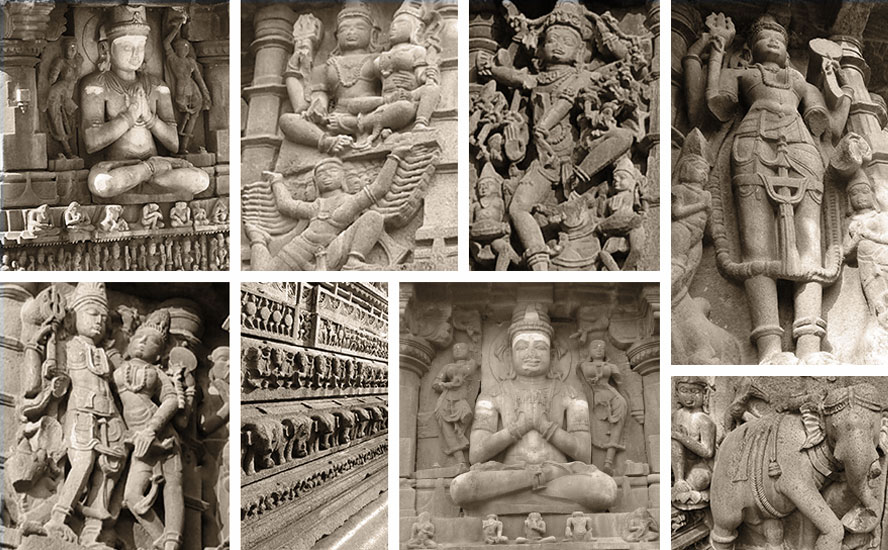
Like the Temples of the Yadava era in Maharashtra, this temple is also developed in the Hemadpanti Style. Creatively, the temple is embellished in the Hemadpant Style as per Dr. Shivakant Vajpayee, an expert in ancient history, culture and archaeology.
The temple is tied in the Panchayatan style, with its black stones and interlocking specialties. This means that the temple surrounded by ancient temples from all the four sides.
Specially mentioning about the octagonal pillars of the temple, Dr. Vajpayee attributes its huge circular shape, a great display of workmanship.
In today’s time, such perfection in work is rarely seen without the use of machines. Dr Vajpayee also told that, the interior and exterior design along with the huge ceiling built with a single stone is also a unique example of the Hemadpanti style.
The entrance of the temple is west-facing, guarded by Jai-Vijay on both the sides. The two lion faced Kirtimukhs engraved there, reminded us of Sri Sanket Dikshit, a theologist of the divine Triyambank. He once told us that the presence of Kirtimukhs, walls, watershrines, stairs to climb the entrance and stairs to go down in the Garbha Grih are mandatory in a Shivalaya. The tale of the Kirtimukh is also quite interesting.
Kirtimukh, the huge and brave lion-like man who was originated from the eyebrows of Bholenath Shiva, once went ahead to prey on Rahu in a rage of hunger. However, he was ordered by lord Shiva to stop. The helplessly hungry creature then started eating his own body. Seeing his devotion the almighty gave him a safe-conduct and stated that it would be beneficial for all Shiva devotees to bow infront of Kirtimukh before having Shiva’s darshan.
Now we were inside the Shivalaya, the plenitude in perspective of design and sculpture as clear from outside is similarly unique inside too. The disk-shaped 12 corner roof of this Jyotirlinga has a circular pavilion in the centre, the sideways is octagonal based on octagonal pillars.
The archway, pylon, auditorium, entrance, pillars and roof are all engraved with sculptures. The varied forms of demigods, Navagrah Vishnu, Agni, Kashyap, Rishi, Bramha and Tridev seem to showcase the highest standards of architectural craft. Showing us the pillars engraved with unique snake patterns having the head below and the tail up, Pandit Sri Darshan pathak told us that these inverse snake drawings are representative of the fact that the name Aundha would have been derived form hindi word Aundha(meaning inverse).
The Utterly Astonishing Garbh Grih Setup
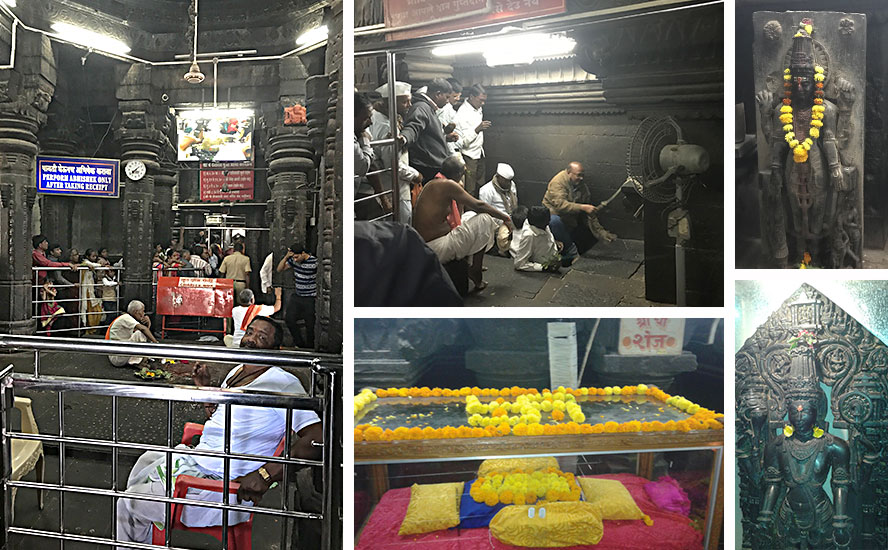
The aligned devotees can enter the Garbh Grih from the embellished entrance . Here the Garbh Grih is not similar to the Auditorium. A half feet Archa-Vigrah of the ingenerated Jyotirlinga is established here. The arrangement of this Garbh-Grih, based on 22.5 feet wide and 25 feet long 4 pillars of 4 feet height, is however absolutely astonishing.
Here one should appreciate the management of the temple, that efficiently manages and control the thronging devotees in such an acutely built premises and more so, when the narrow entry of the Garbh Grih can take only one devotee at a time. The process to squat and reach the prime creator might be difficult, but one cannot restrict oneself from being an ardent Shiva admirer once coming face to face with the divine idol. The water stream incessantly flowing upon the one who’s the beginning, middle and the end of the universe, and the tripartite Bilwapatra, Trinetra, Tripund, and Trishul symbolising the coordination of Satvagun-Rajogun and Tamogun will leave you completely Shivmay.
What else a Bhagwad worshipper could expect but the Bhagwad. Senior pastor Pandit Dinesh Lakshmanrao Pathak told us that a divine form of Shiva and Vishnu are be-seated in the Garbha Grih. Here both exist in spiritual and defined forms. This is why offering Manjari and Tulasi leaves along with Bilwapatra to the owner of the world, the lord of the lords, the reason of the reasons, is a tradition here.
The divine Look of Shiva and Vishnu in the Garbh Griha
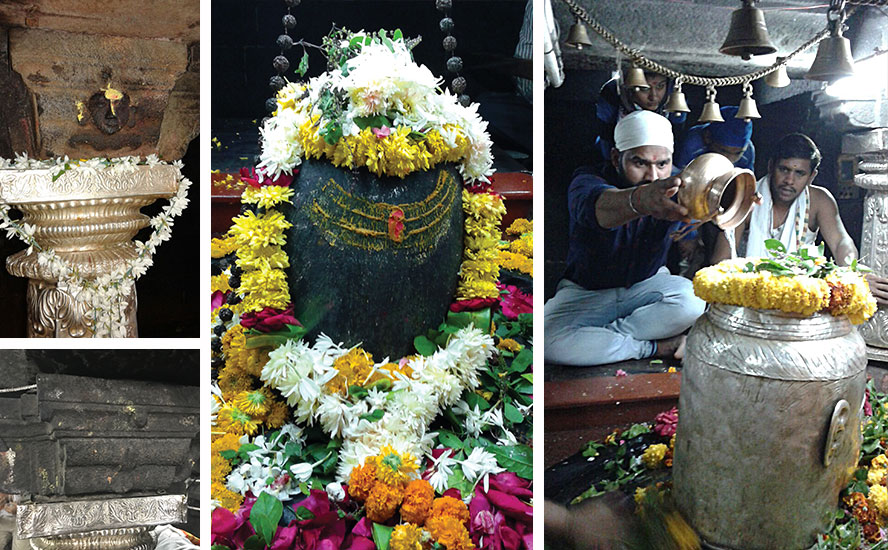
In the Garbha Grih, Purohit Sri Pathak told us that the Shivalaya opens at around 5 in the morning. At twelve the temple area resonates the echoes of drums during the aarti and the mahabhog. The meridiem bath is performed from 4 to 4.30 pm while the night aarti is performed between 8 and 9pm. After the night aarti, a special prasad of Pedas and Tambul is distributed. The Naivedya is offered to the lord in a silver plates brought in from the homes of about 30 odd priests serving in the temple. The offerings consists of all the delicacies of Maharashtra along with the famous PuranPoli.It is believed that after the Night Aarti, the lord of devastation, Shiva rests in the decorated sanctorum. Purohit Sri Nagnath Lakshman Rao Pathak also joined the conversation now, his eight generations have served the temple with complete dedication, worshiping the almighty Lord Shiva. As per him, it was Yudhisthir, who while being in the forest, saw milk streams flowing on an ingenerated Shivlinga at the campus of Armadak Lake.
Bheem initiated the demolition of the bridge in an attempt to take out a sparkling Pindi from the hot water. It’s a buzz that as the shining Pindi was many a times brighter than the Sun, it made differentiation between dawn and dusk extremely difficult.
The Pandavas made around 20 unsuccessful attempts, but were unable to cool down the luster of the Pindi. In this situation, Bheeem coated the Pindi with the sand of Gandaki river and Yudhisthir auspiciously placed the Pindi following all the religious traditions and ceremonies.
This tale is quite well known too. Touching the Jyotirlinga, one can feel the texture of the sand on it.
The Air-conditioned Garbhatal of the temple makes it necessary to mention the effective management of the Temple Trust. The air conditioning keeps the Garbhatal cool and airy all the time. After the Jalabhishek, the devotees are escalated upstairs by the volunteers, holding the ropes hanged for the support.
Coming up from the Garbhatal we can see the crested crown adorning embellished idol of lord Vishnu. The divine Vishnu idol from the era of Saint Namdev was unearthed from the southeastern side of the temple in 1973.
The delightful and interesting tales of Lord Shiva left us wondering, that the one with his mighty powers, poses as the Bramha, Vishnu and Rudra to create, foster and destroy the world and its beings while donning a ternary look by illusion.
The Nandikeshwar temple in the Compound
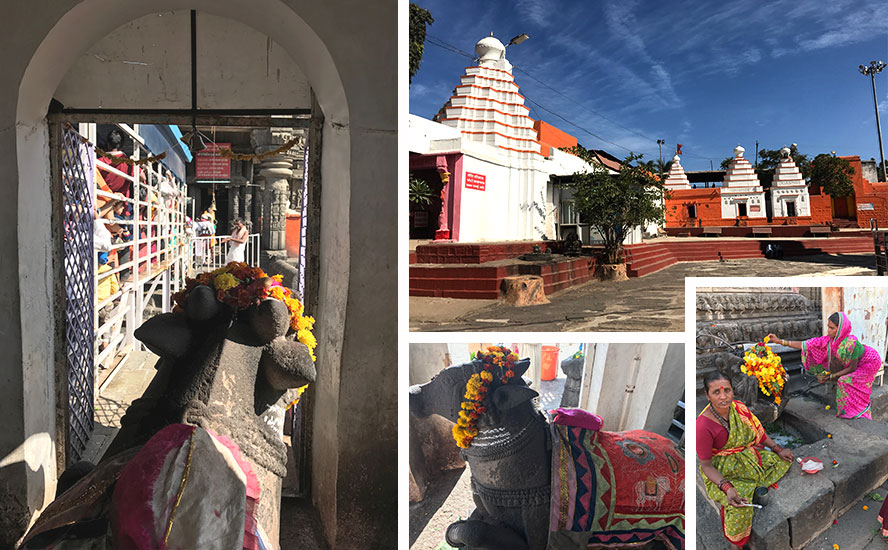
Now we had reached the compound, just infront of the Nandikeshwar temple. It is an unusual aspect of the Shivalaya which attracted our attention. Here, Nandi is unusually be seated in the opposite direction unlike in all other Shiva temples. In this regard, Purohit Sri Darshan Pathak told us that this land is blessed with the footsteps of sages like Gyaneshwar, Naamdev, Visoba Khechar, Nivruttinath, Tukaram, Tukobarai, Sopan, Sena, Muktaabai, Narhari, and Goraba. Actually the era of 1275 was the golden era of the varkari community of Maharashtra. It is believed that, once when the supreme sage Namdev was chanting bhajans in the campus, it was considered as a hindrance in the Poojan and he was ordered to go to the backside of the temple. The benevolent Nageshwara was touched seeing his devotion and shivbhakti and he turned the face of the Temple itself towards Namdev. The Mahanubhav granth was penned in the era of Sant Gyaneshwar’s era, in which there is a reference regarding this sacred Jyotirlinga. The granth came into being in the middle of 1208, this era is even 4 years before the era of sant Gyaneshwar.
The Sant Namdev temple in the shivalaya compound is also the representative Samadhi of Sant Visoba. In context of Sant Visoba Khechar, it is believed that once en route to Pandharpur, a group of Saints gathered at Goroba’s place. Goraba kaka advised them to visit the Nagnath campus in Aundha village to
to seek guidance from Sant Visoba Khechar and get Guru Updesh.
When Namdev entered the campus, he saw an old man relaxing in the temple, keeping his feet on the Shivlinga. Miraculously a new Pindi was formed, each time he tried to remove the feet of the old man from the Shivlinga.
This is when Sant Visoba gave the message to his pupils that “ the almighty is omnipresent and utmost devotion leads you on the way to god.” The 108 Pindis in the Temple area attest this folktale.
We move forward, bowing to the prosperous and pious Saint Culture of Maharashtra. In the campus, the temples of Kankeshwari devi, Khandeshwari devi, Padmavdevi who are regarded equal to Tulja Bhavani, Maahur and Mahalakshmi.The Rinmukteshwar kund also known as The Saas-Bahu Kund is nearby. The kund, once used to wash off the sins, is now filled with algae.
Apart from these, the Bhagveshwar, Khandoba, Chintamani, Dattatreya, Nilkantheshwar, Bhaktachi Aai, Gokarneshwar, aadinath Mahadev and Shankarachrya Temple are also places of belief.
Instances of Maryada Purushottam Ram visiting Aundha, Parli and Ambejubai areas have a mention in the Vijay Yatra episode’s Seventh Kaand of the 12 thousand shloka Anand Ramayan Grantha from 15th Century.
The magnanimous poet Dimbh has also discussed “Sorti Somnatha, Aavandhe Naagnath amardak tapovan”.
Renowned reformer late. N.S. Pohanerkar got the written scripture in 1762, which was written 400 years ago. The information of the popularity of the Nagnath in Aundha was described in the 37 Adhyays and 2620 Shlokas of the same. The mention of Sri Naagnath Jyotirlinga is cited with testimonies in several time-worn scripture of Maharashtra.
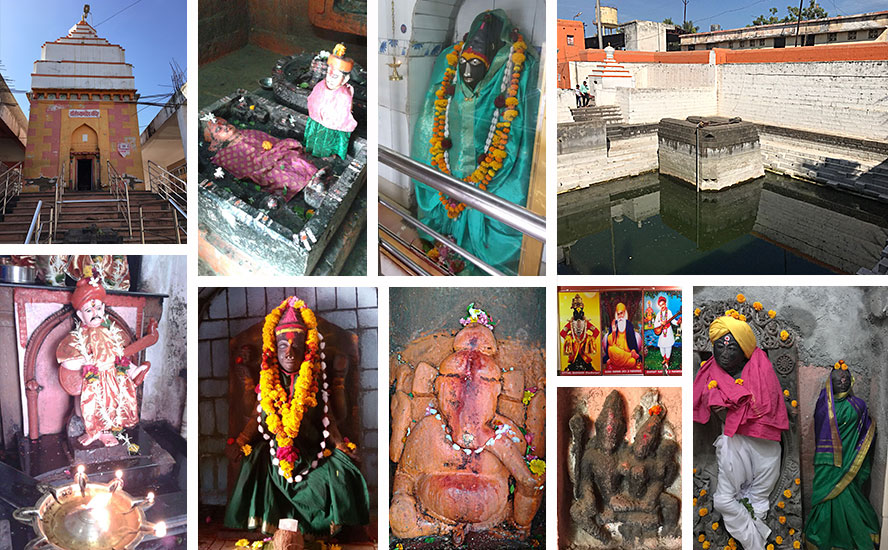
We were astonished with the huge presence of Sikh devotees in the premises. We were told that the greatness of Shiv Upasana has been mentioned in the Dasham Granth Saheb penned by the last Guru of the Sikh Community Sant Sri Guru Govindsinghji Maharaj. The quotes of Sant Naamdev are also compiled in the first sacred Gurugranth Sahib.
As we observed the Indian culture of Worldy brotherhood, we moved ahead taking pride in our rich culture which believes in Unity in Diversity. Although the question of “ Nagesham daruka vane” was still there on our minds. Reasearcher Sri Rajesh Dikshit explained the situation saying that the “Daruka” being the place of the Daitya couple is known as Nagesham Daruka Van.
Yaamye Sange Nagaretiramye
Vibhushitang vividhaishwa bhoge
Sadbhakti muktipradaishamekam
Sri naagnaathan sharanm prapadye
It means that “I seek shelter from the great Prabhu Sri Naagnath,
the one living in the blissed town of Sange in the south, the one prosperous with several luxuries embellished with beautiful ornaments, the one and only to show us the path of salvation and moksha.”
Jagatguru Aadi Shankaracharya marked Sri Naagnath Jyotirlinga as prime Jyotirlinga as it was situated in the South direction. We also got to know that the historical name of Aundha was Sange, mentioned in the Shloka as “yaamye sange naagre”.
Now, as Maharashtra is situated in South direction whereas Sri Jogeshwar of Uttarakhand is in North and Sri Naag Nageshwar of Gujarat is in West, the Naagnaath jyotirlinga in Aundha would be considered to be among the 12 Jyotirlingas.
It was a happy coincidence that we got a book “Dwaadash Jyotirlinga” penned by Gujarat’s renowned author Late Sri Ramesh Thakar, in the temple through his relatives. The author has described Daruka Van in a creative script. The Daitya duo Daruka and Daruki used to live in the west coast of India. Daruka was an atheist whereas Daruki was a believer. Appeasing Devi Parvati, Daruki gained a blessing that wherever she would go, the forest and rains will follow.
Out of pride and ego, Daruka and Daruki then started disturbing the Sages and there Saadhna. The suffering people approached King Maharishi Aurve. Appeased with his Anushthans Lord Indra professed along with Devas to help them. Seeing this, Deamon Daruka and Daruki left to live on the Nirmal Hills, in the northern state of river Godavari. Here they gained control over the people of the hills and since then this forest came to be known as Daruka Van.
Once several glorious ferries reached the Godavari river. The daemons attacked these vessels and took all the people hostage. Amongst these hostages was an ardent Shiv follower, Vaishya Supriya.
He used to eat only after performing proper rituals and prayers. Once a deamon loyal to Daruk saw him engrossed in performing his rituals and informed about the same to the daemon king. The king with all his army landed in the prison. Unaffected with this sudden development, Supriya said “ I am Lord Shiva’s Devotee and I am worshiping him” saying this he went ahead to do his rituals. When Lord Shiva, who was already present there, saw Supriya being attacked, he stung Daruka, impersonating a snake. Not only this, he destroyed all the daemons present there. Freed from the anguish of the daemons, Supriya prayed and requested the almighty Shiva to stay in the forest. Since then the lord of three worlds, Shiva is present here in the form of a Jyotirlinga.
The Jyotirlinga started being worshiped in the name of Sri Naagnath and this sacred Shiv Dhaam was later renowned as Sri Naageshwar Jyotirlinga. However after this, Shakti Upasika Daruki called Parvati Ji. On the request of Goddess Parvati, Lord Shiva announced the stay of Daruk lineage in the area.
He also said that when the royal King named Veerasen will visit this place with the advent of Satyuga, he will win over and destroy all the deamons. However, Ramesh Thakar has a different view, he mentions that the geographical structure of daruki is such that one cannot even imagine of a forest range here. Declaring the Nageshwar Mahadev situated near Dwaarika as a Jyotirlinga, just on the resemblance or phonetic resemblance of Dwarika with Daaruki is unfair as Naageshwar Jyotirlinga is situated near Gopi Lake. We also believe, that as the last destination of all the streams is to be unified in the ocean, similarly we, with all our logics, contradictions, devotion shoul unify in Shiv Tatva in the end. This is the only Truth. The origin of word Shiva itself is from “Vash Kanto Saadhu” which itself means amiable or Shiva. He belongs to everyone….everyone belongs to him…
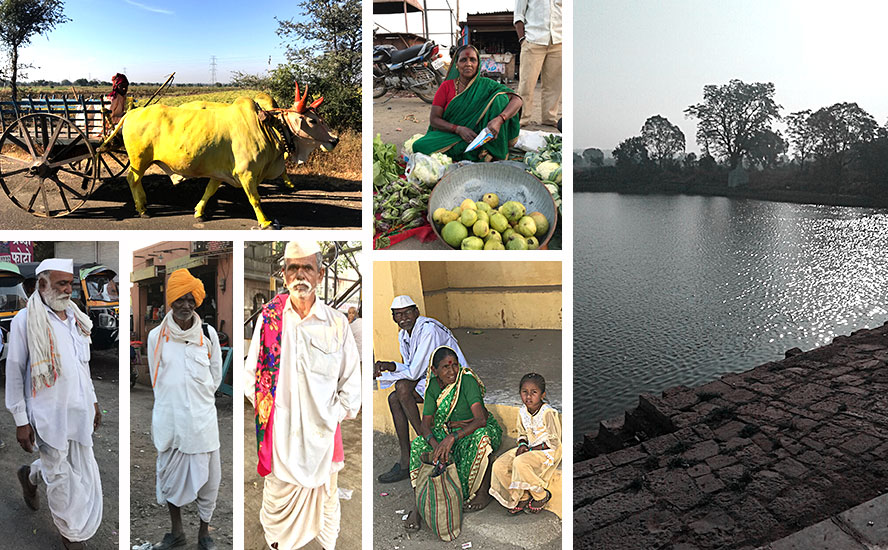
Near to this Shivalaya is the Hariharatmak Lake, infront of the shrine of lord Hanuman. Devotees suffering from Voice problems of the child come here for blessings and offer food to the monkeys. Looking at sparrows flocking in the pleasantness of the nature, the thought crossed our mind, that why do we have to wait for the Vishwa Goraiyya Diwas every year on 20th March, for the conservation of these Sparrows, searching their existence in the cities. Savoring the Chichdi Bhaji, listening to the blissful fusion of the tweets of Parrots, Pigeons and Peacocks we left from Aundha. On this short winter day, as the Sun was ready to set in the dark lake, leaving behind the shades of umber in the sky, just like a young saint… were wondering, how about staying and living some more moments on the pious land of Maharashtra!
